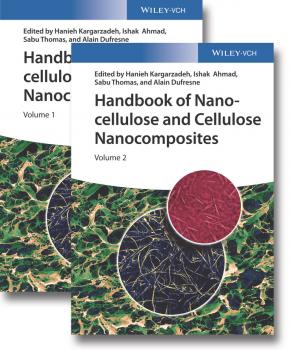ТОП просматриваемых книг сайта:
Sabu Thomas
Список книг автора Sabu ThomasАннотация
A comprehensive overview of the main characterization techniques of polymer electrolytes and their applications in electrochemical devices Polymer Electrolytes is a comprehensive and up-to-date guide to the characterization and applications of polymer electrolytes. The authors ? noted experts on the topic ? discuss the various characterization methods, including impedance spectroscopy and thermal characterization. The authors also provide information on the myriad applications of polymer electrolytes in electrochemical devices, lithium ion batteries, supercapacitors, solar cells and electrochromic windows. Over the past three decades, researchers have been developing new polymer electrolytes and assessed their application potential in electrochemical and electrical power generation, storage, and conversion systems. As a result, many new polymer electrolytes have been found, characterized, and applied in electrochemical and electrical devices. This important book: -Reviews polymer electrolytes, a key component in electrochemical power sources, and thus benefits scientists in both academia and industry -Provides an interdisciplinary resource spanning electrochemistry, physical chemistry, and energy applications -Contains detailed and comprehensive information on characterization and applications of polymer electrolytes Written for materials scientists, physical chemists, solid state chemists, electrochemists, and chemists in industry professions, Polymer Electrolytes is an essential resource that explores the key characterization techniques of polymer electrolytes and reveals how they are applied in electrochemical devices.
Аннотация
Sets forth the techniques needed to create a vast array of useful biopolymer nanocomposites Interest in biopolymer nanocomposites is soaring. Not only are they green and sustainable materials, they can also be used to develop a broad range of useful products with special properties, from therapeutics to coatings to packaging materials. With contributions from an international team of leading nanoscientists and materials researchers, this book draws together and reviews the most recent developments and techniques in biopolymer nano-composites. It describes the preparation, processing, properties, and applications of bio- polymer nanocomposites developed from chitin, starch, and cellulose, three renewable resources. Biopolymer Nanocomposites features a logical organization and approach that make it easy for readers to take full advantage of the latest science and technology in designing these materials and developing new products and applications. It begins with a chapter reviewing our current understanding of bionanocomposites. Next, the book covers such topics as: Morphological and thermal investigations of chitin-based nanocomposites Applications of starch nanoparticle and starch-based bionanocomposites Spectroscopic characterization of renewable nanoparticles and their composites Nanocellulosic products and their applications Protein-based nanocomposites for food packaging Throughout the book, detailed case studies of industrial applications underscore the unique challenges and opportunities in developing and working with biopolymer nanocomposites. There are also plenty of figures to help readers fully grasp key concepts and techniques. Exploring the full range of applications, Biopolymer Nanocomposites is recommended for researchers in a broad range of industries and disciplines, including biomedical engineering, materials science, physical chemistry, chemical engineering, and polymer science. All readers will learn how to create green, sustainable products and applications using these tremendously versatile materials.
Аннотация
Filling the gap for a reference dedicated to the characterization of polymer blends and their micro and nano morphologies, this book provides comprehensive, systematic coverage in a one-stop, two-volume resource for all those working in the field. Leading researchers from industry and academia, as well as from government and private research institutions around the world summarize recent technical advances in chapters devoted to their individual contributions. In so doing, they examine a wide range of modern characterization techniques, from microscopy and spectroscopy to diffraction, thermal analysis, rheology, mechanical measurements and chromatography. These methods are compared with each other to assist in determining the best solution for both fundamental and applied problems, paying attention to the characterization of nanoscale miscibility and interfaces, both in blends involving copolymers and in immiscible blends. The thermodynamics, miscibility, phase separation, morphology and interfaces in polymer blends are also discussed in light of new insights involving the nanoscopic scale. Finally, the authors detail the processing-morphology-property relationships of polymer blends, as well as the influence of processing on the generation of micro and nano morphologies, and the dependence of these morphologies on the properties of blends. Hot topics such as compatibilization through nanoparticles, miscibility of new biopolymers and nanoscale investigations of interfaces in blends are also addressed. With its application-oriented approach, handpicked selection of topics and expert contributors, this is an outstanding survey for anyone involved in the field of polymer blends for advanced technologies.
Аннотация
Polymer composites are materials in which the matrix polymer is reinforced with organic/inorganic fillers of a definite size and shape, leading to enhanced performance of the resultant composite. These materials find a wide number of applications in such diverse fields as geotextiles, building, electronics, medical, packaging, and automobiles. This first systematic reference on the topic emphasizes the characteristics and dimension of this reinforcement. The authors are leading researchers in the field from academia, government, industry, as well as private research institutions across the globe, and adopt a practical approach here, covering such aspects as the preparation, characterization, properties and theory of polymer composites. The book begins by discussing the state of the art, new challenges, and opportunities of various polymer composite systems. Interfacial characterization of the composites is discussed in detail, as is the macro- and micromechanics of the composites. Structure-property relationships in various composite systems are explained with the help of theoretical models, while processing techniques for various macro- to nanocomposite systems and the influence of processing parameters on the properties of the composite are reviewed in detail. The characterization of microstructure, elastic, viscoelastic, static and dynamic mechanical, thermal, tribological, rheological, optical, electrical and barrier properties are highlighted, as well as their myriad applications. Divided into three volumes: Vol. 1. Macro- and Microcomposites; Vol. 2. Nanocomposites; and Vol. 3. Biocomposites.
Аннотация
Polymer composites are materials in which the matrix polymer is reinforced with organic/inorganic fillers of a definite size and shape, leading to enhanced performance of the resultant composite. These materials find a wide number of applications in such diverse fields as geotextiles, building, electronics, medical, packaging, and automobiles. This first systematic reference on the topic emphasizes the characteristics and dimension of this reinforcement. The authors are leading researchers in the field from academia, government, industry, as well as private research institutions across the globe, and adopt a practical approach here, covering such aspects as the preparation, characterization, properties and theory of polymer composites. The book begins by discussing the state of the art, new challenges, and opportunities of various polymer composite systems. Interfacial characterization of the composites is discussed in detail, as is the macro- and micromechanics of the composites. Structure-property relationships in various composite systems are explained with the help of theoretical models, while processing techniques for various macro- to nanocomposite systems and the influence of processing parameters on the properties of the composite are reviewed in detail. The characterization of microstructure, elastic, viscoelastic, static and dynamic mechanical, thermal, tribological, rheological, optical, electrical and barrier properties are highlighted, as well as their myriad applications. Divided into three volumes: Vol. 1. Macro- and Microcomposites; Vol. 2. Nanocomposites; and Vol. 3. Biocomposites.
Micro- and Nano-Structured Interpenetrating Polymer Networks. From Design to Applications - Sabu Thomas
Аннотация
This book examines the current state of the art, new challenges, opportunities, and applications of IPNs. With contributions from experts across the globe, this survey is an outstanding resource reference for anyone involved in the field of polymer materials design for advanced technologies. • Comprehensively summarizes many of the recent technical research accomplishments in the area of micro and nanostructured Interpenetrating Polymer Networks • Discusses various aspects of synthesis, characterization, structure, morphology, modelling, properties, and applications of IPNs • Describes how nano-structured IPNs correlate their multiscale structure to their properties and morphologies • Serves as a one-stop reference resource for important research accomplishments in the area of IPNs and nano-structured polymer systems • Includes chapters from leading researchers in the IPN field from industry, academy, government and private research institutions
Аннотация
This book comprehensively reviews research on new developments in all areas of food chemistry/science and technology. It covers topics such as food safety objectives, risk assessment, quality assurance and control, good manufacturing practices, food process systems design and control and rapid methods of analysis and detection, as well as sensor technology, environmental control and safety. The book focuses on food chemistry and examines chemical and mechanical modifications to generate novel properties, functions, and applications.
Handbook of Biopolymer-Based Materials. From Blends and Composites to Gels and Complex Networks - Sabu Thomas
Аннотация
This first systematic scientific reference in the area of micro- and nanostructured biopolymer systems discusses in two volumes the morphology, structure, dynamics, properties and applications of all important biopolymers, as well as their blends, composites, interpenetrating networks and gels. Selected leading researchers from industry, academia, government and private research institutions around the globe comprehensively review recent accomplishments in the field. They examine the current state of the art, new challenges, and opportunities, discussing all the synthetic routes to the generation of both micro- and nano-morphologies, as well as the synthesis, characterization and application of porous biopolymers. An outstanding resource for anyone involved in the fi eld of eco-friendly biomaterials for advanced technologies.
Аннотация
An up-to-date and comprehensive overview summarizing recent achievements, the state of the art, and trends in research into nanocellulose and cellulose nanocomposites. Following an introduction, this ready references discusses the characterization as well surface modification of cellulose nanocomposites before going into details of the manufacturing and the self-assembly of such compounds. After a description of various alternatives, including thermoplastic, thermosetting, rubber, and fully green cellulose nanocomposites, the book continues with their mechanic and thermal properties, as well as crystallization and rheology behavior. A summary of spectroscopic and water sorption properties precedes a look at environmental health and safety of these nanocomposites. With its coverage of a wide variety of materials, important characterization tools and resulting applications, this is an essential reference for beginners as well as experienced researchers.
Аннотация
Epoxy resins are polymers which are extensively used as coating materials due to their outstanding mechanical properties and good handling characteristics. A disadvantage results from their high cross-link density: they are brittle and have very low resistance to crack growth and propagation. This necessitates the toughening of the epoxy matrix without impairing its good thermomechanical properties. The final properties of the polymer depend on their structure. The book focuses on the microstructural aspects in the modification of epoxy resins with low molecular weight liquid rubbers, one of the prime toughening agents commonly employed. The book follows thoroughly the reactions of elastomer-modified epoxy resins from their liquid stage to the network formation. It gives an in-depth view into the cure reaction, phase separation and the simultaneous development of the morphology. Chapters on ageing, failure analysis and life cycle analysis round out the book.










